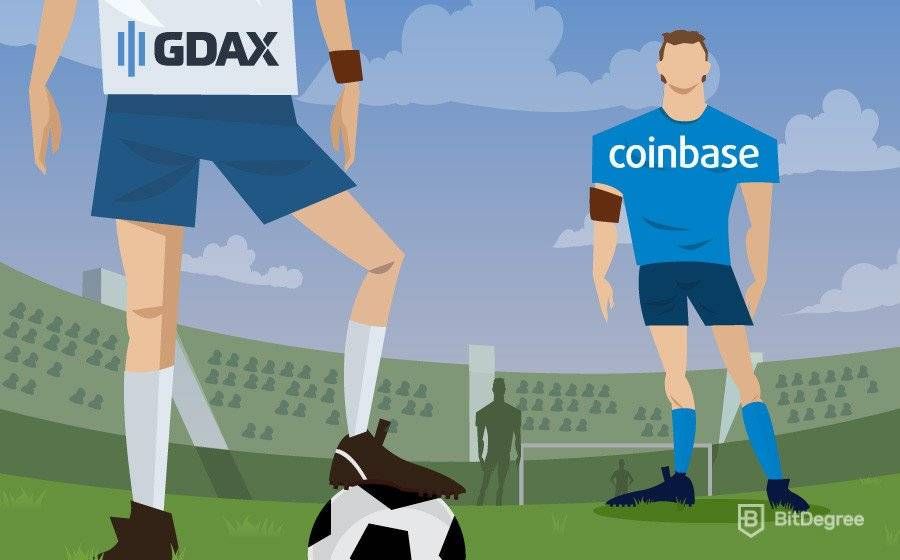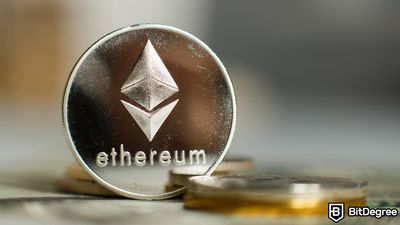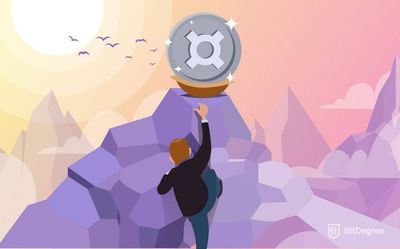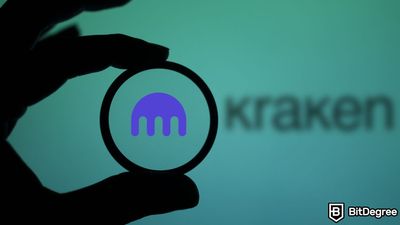Are you looking to start buying, selling, or trading cryptocurrencies, and want to know the difference between GDAX VS Coinbase? Sit tight, as I’m going to be dissecting the two of them in a full-length comparison, helping you to decide which one you prefer!
By the way, did you know that GDAX recently announced that it is going to re-brand to ‘Coinbase Pro’? Don’t worry, I’ll call it GDAX so you don’t get confused!
In my GDAX VS Coinbase guide, I am first going to start by giving a brief overview of how the platforms started, followed by a summary of what they do.
After that, I am going to give you a comprehensive guide on how they compare, including things such as Coinbase VS GDAX fees, features, accepted payment methods, coin availability, and security!
So, what are you waiting for? The first part of my GDAX VS Coinbase guide is going to look at who Coinbase are and how they started!

Did you know?
Want to get smarter & wealthier with crypto?
Subscribe - We publish new crypto explainer videos every week!
What is the Metaverse? (Meaning + Animated Examples)
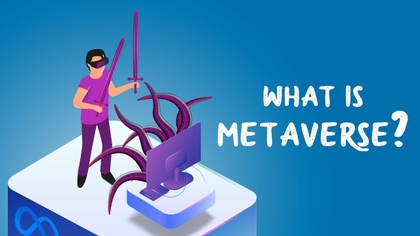

Table of Contents
- 1. Exchanging Crypto on Coinbase
- 2. Exchanging Crypto on GDAX
- 3. GDAX VS Coinbase Fees & Payment Methods
- 3.1. Coinbase
- 3.2. GDAX
- 4. GDAX VS Coinbase: Features and User-Friendliness
- 5. GDAX VS Coinbase: Coin Availability
- 6. GDAX VS Coinbase: Security
- 7. Coinbase’s Advantages and Disadvantages
- 8. GDAX’s Advantages and Disadvantages
- 9. Conclusion
Exchanging Crypto on Coinbase
Coinbase is an exchange broker that allows people to buy and sell a range of cryptocurrencies. Created in 2012, the company is headquartered in San Francisco, California. Although the platform is not available to everyone, they now allow people from more than 30 different countries to open an account.
Latest Deal Active Right Now:
CLAIM $600 REWARD
Exclusive Binance Referral Code
Don't miss this limited-time deal that's only available for our readers. Use the Binance referral code 49316610 & receive up to $600 in rewards and bonuses!
Coinbase is very popular because they offer a really simple way to get involved in cryptocurrency for the first time, as they allow users to deposit funds using either a debit/credit card or bank account.

My Coinbase VS GDAX guide found that the exchange is now so popular that they have served over 20 million customers and processed more than $150 billion in transactions! Led by CEO Brian Armstrong, the platform is growing so quickly that it now has over 535 employees and an estimated yearly revenue of $1 billion.
When a cryptocurrency is listed on Coinbase, it often tends to add significant value to the price of the coin because the platform makes it easy to buy using real-world money. It offers unprecedented liquidity to the coin, and opens it up to a much bigger audience.
For example, it was recently revealed that Ripple (XRP) offered to lend Coinbase $100 million worth of their cryptocurrency for the exchange to list their coin!
When you purchase cryptocurrencies from Coinbase, you are buying directly from the platform. This is different from most other exchanges, where you normally trade directly with other users.
So, now that you know the background of Coinbase, the next part of my GDAX VS Coinbase guide is going to look at GDAX! Need more info about Coinbase? Read my full review here.
Exchanging Crypto on GDAX
Created in 2016, Global Digital Asset Exchange (GDAX) is a cryptocurrency exchange that allows people to buy, sell, and trade a range of coins. Interestingly, the platform is owned by the same organization that runs Coinbase.
Unlike Coinbase, GDAX is suited for the more experienced trader, as the platform offers a lot more features. When people decide to use GDAX to trade, they are buying or selling directly with other users. In this sense, the purpose of GDAX is to match buyers to sellers.
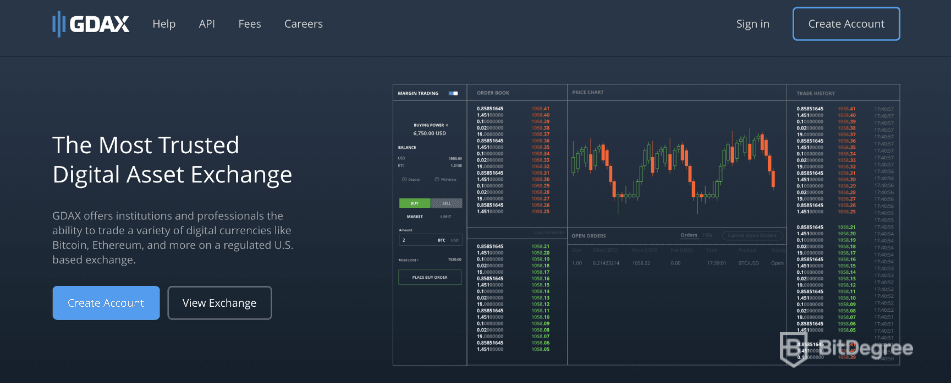
GDAX also allows its users to deposit funds using real-world money and if you already have a Coinbase account, you can easily transfer your funds across to GDAX. In late 2017, GDAX reached new records when it processed more than $650 million worth of trades in just 24 hours!
Although there are some similarities between the two platforms, the next part of my GDAX VS Coinbase guide is going to break down their clear differences!
GDAX VS Coinbase Fees & Payment Methods
Let’s start defining their clear differences by taking a look at their fees and payment methods, beginning with those of Coinbase!
Coinbase
One of the best benefits of using Coinbase is that they have a facility that allows users to deposit funds using real-world fiat currency. If you are located in Australia, Canada, Singapore, the United States, or most European nations (including the United Kingdom), then you can fund your account using either a debit/credit card, or bank account.
My Coinbase VS GDAX review found that, before you can do this, you will need to complete a KYC (Know-Your-Customer) process, which requires you to identify yourself. This will initially require you to provide your personal information (such as your name, address, and nationality), which you will then need to verify by uploading a copy of your national identity card (such as a passport or driver’s license). Once you have done this, you can make a deposit.

If you decide to fund your account using a debit or credit card, the standard Coinbase fees are 3.99%. Although this might sound expensive, the platform has to do this to protect themselves from a chargeback or fraudulent activity.
It is also possible to deposit using a bank account, with the fee depending on the type of transfer you are making. For example, if you are from Europe and depositing with SEPA, then it is free. On the other hand, U.S. customers using a U.S. bank account will pay 1.49%.
Alternatively, Coinbase also allows you to deposit using a cryptocurrency. If you decide to do this, the only charge you will have to pay is the blockchain transaction fee.
When it comes to withdrawing your funds, you can also use real-world payment methods. Again this depends on the type of bank account you have, with SEPA costing $0.15 and $25 if using a standard wire transfer (U.S.). Coinbase also allows you to withdraw funds using PayPal, which costs a flat rate of 3.99%.

Coinbase also makes money when you buy or sell cryptocurrencies. When you enter the number of coins you want to trade, the platform will include a 1.49% fee on top of the current market price. For example, if you want to buy $200 worth of Bitcoin, then your account will be credited with $197.20 worth of coins.
Although this might sound more expensive than other cryptocurrency exchange brokers, it is important to remember that the prices you pay at Coinbase are not far away from the actual market price!
The next part of my GDAX VS Coinbase fees section is going to look at GDAX.
GDAX
Just like Coinbase, GDAX also allows its customers to deposit funds using real-world fiat currency. However, they only support bank accounts. As a result, if you want to use a debit or credit card, you will need to deposit into Coinbase and then transfer the funds to GDAX!
The GDAX fees associated with bank account deposits and withdrawals are the same as Coinbase. Furthermore, GDAX doesn’t charge you to deposit and withdraw using cryptocurrencies, however, you will need to pay the blockchain fee.
When it comes to trading, GDAX fees are some of the cheapest in the industry. It can get a little confusing, though, so let me explain how it works.
The fees that you are charged to buy and sell cryptocurrencies depend on the amount that you trade over 30 days. The platform determines this by calculating your trading volume in USD. If you are not trading USD (for example, Bitcoin against Ethereum) then GDAX will convert the trade amount into dollars.

To make things even more confusing, GDAX will charge you depending on whether you are a market ’Maker’ or a market ‘Taker’. The maker is the person that offers liquidity and sets the price and the taker is the person that buys or sells at that price.
GDAX is fantastic for market makers, as they do not charge any trading fees! On the other hand, if you are a taker, you will pay 0.30%. If you are a heavyweight trader and buy or sell more than $10 million worth of cryptocurrency in a single month, then this fee goes down to 0.20%. Anyone that trades more than $100 million in a month can reduce this even more, right down to 0.10%, which is perfect for institutional investors!
So, now that I’ve covered the GDAX VS Coinbase fees, the next part of my GDAX VS Coinbase guide is going to look at their features and user-friendliness!
GDAX VS Coinbase: Features and User-Friendliness
As I mentioned earlier, Coinbase is perfect for people who are entering the cryptocurrency industry for the first time because they allow you to easily buy coins using traditional payment methods. As a result, the platform is probably the most user-friendly exchange available!
However, other than buying coins from Coinbase or selling coins to Coinbase, the number of features are quite limited. Nevertheless, some people also use Coinbase as an online wallet. Instead of withdrawing their coins out of the platform, it is possible to keep them inside your Coinbase wallet. Furthermore, you can also transfer coins from your Coinbase account over to GDAX.

On the other hand, GDAX offers much more to its customer base. My Coinbase VS GDAX review found that users can buy and sell coins in various ways, including margin orders, limit orders, and stop orders. If you are unsure what these terms mean, I’ll briefly explain them below.
- Market Order. If you open a margin account, you can essentially trade more than you have. By ‘borrowing’ money from the broker, you can increase the amount of leverage you have. This feature is more suited for advanced traders, as the risks are much higher.
- Limit Orders. By using the limit order feature, users can choose a certain price that they want to buy or sell a cryptocurrency. For example, if Bitcoin was priced at $6500, but you thought it was going to go down the next day, you could set a limit order at $6200. If and when the price went down to $6200, the exchange can automatically buy the coin for you.
- Stop Orders. When choosing the stop order feature, you can limit the losses of a certain trade. For example, if you bought the Ethereum at $700, you could set a stop order at $500. If the markets crashed and Ethereum's price kept falling, then the exchange can close the trade automatically on your behalf.
By trading at GDAX, it is also possible to perform in-depth chart analysis. The platform allows you to view real-time and historical data in lots of different ways, which is great for predicting which way the market is going to move.

It is important to remember that all of these extra features that GDAX offers are probably not suited for beginners. Just make sure that you know how each feature works before you risk your own money!
So, now that you know the difference between Coinbase and GDAX features, the next part of my GDAX VS Coinbase guide is going to look at which coins they have available!
GDAX VS Coinbase: Coin Availability
Although Coinbase is a fantastic exchange broker for first-time buyers, my GDAX VS Coinbase guide found that it is very limited in the coins it lists. At the time of writing in July 2018, Coinbase supports just four cryptocurrencies, which I have listed below.
In early 2018, the team at Coinbase announced that they were going to start supporting some more alt-coins very shortly. Lots of people thought that Ripple would be the first addition to the list, however, in June 2018, Coinbase confirmed that it would be Ethereum Classic (ETC)!
This was a bit surprising, as Ripple has a much higher market capitalization than Ethereum Classic, however, they did not explain why they made the decision.
Moving on, when it comes to GDAX, they also only support four different cryptocurrencies! Just like Coinbase, these are Bitcoin, Ethereum, Bitcoin Cash, and Litecoin. The main difference is that there are lots of different trading pairs available, against both cryptocurrencies and fiat currencies. For example, you can trade LTC/EUR, BCH/EUR, and LTC/BTC!
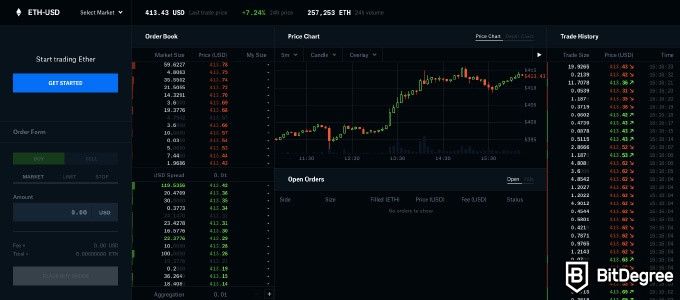
Although it hasn’t been confirmed yet, most people think that GDAX will also be supporting Ethereum Classic, just like Coinbase.
Overall, the fact that both platforms only accept 4 coins is a bit disappointing. For example, other exchanges such as Binance have hundreds of different cryptocurrencies that you can buy, sell, and trade, so hopefully, in the future, more cryptocurrencies are added.
So now that you know which coins are supported, the next part of my GDAX VS Coinbase guide is going to look at how secure the platforms are!
GDAX VS Coinbase: Security
One of the greatest benefits my GDAX VS Coinbase review found is that both platforms have excellent security features. The parent company claims that they store 98% of all customer funds in cold storage. What this means is that they are held offline, with no connection to any servers.
This makes it practically impossible for a hacker to steal the coins. Furthermore, private customer data is also held offline, ensuring that personal information (such as account logins and payment card numbers) are disconnected from the internet.
Regarding the 2% of customer funds that are held online, Coinbase and GDAX both have safeguards to ensure the coins remain safe. Firstly, users have the option of setting up two-factor authentication (2FA). This is where you need to enter a code that is sent to your mobile phone before you can log in.

Users can also choose to store their coins in the Coinbase/GDAX vault. In doing so, every withdrawal has a time delay of 48 hours. Therefore if your account was hacked and somebody tried to withdraw your funds, you would have 48 hours to cancel the transaction. An additional security feature is a multi-approval option.
This requires more than one person to confirm a withdrawal request before it can be processed. However, I think the best security feature offered by both platforms is that customer funds are protected by FDIC insurance up to $250,000. This means that, if your funds are stolen, or the platform is no longer operational, your funds (as long as they are held in a USD wallet) are covered!
So - now that you know about the excellent security features available on both platforms, the final part of my GDAX VS Coinbase guide is going to summarize the advantages and disadvantages of both exchanges.
Coinbase’s Advantages and Disadvantages
Advantages
- Very user-friendly
- Perfect for first-time buyers
- Accepts bank account and debit/credit cards
- Excellent security
- Great customer support
Disadvantages
- Only lists 4 cryptocurrencies
- Only certain nations accepted
- High fees for debit/credit card payments
- Trading fees not that cheap
- Not many trading features
GDAX’s Advantages and Disadvantages
Advantages
- Accepts bank account deposits and withdrawals
- Really low fees
- Free trading for market makers
- Lots of trading features and tools
- Good liquidity
- Excellent security
Disadvantages
- Does not accept debit/credit cards directly (need to transfer from Coinbase)
- Only lists 4 cryptocurrencies
- Only certain nations accepted
Conclusion
And that’s the end of my GDAX VS Coinbase guide! If you have read it from start to finish, you should now know the difference between Coinbase and GDAX!
This included everything from fees, user-friendliness, security, and more! Ultimately, both exchanges have different purposes.
While Coinbase has been set up for beginners to buy and sell cryptocurrency for the first time, GDAX is suited for more experienced traders. There is no reason why you can’t use both platforms (you will automatically have the other platform open when you register an account)!
I also think Coinbase is ideal for quickly buying cryptocurrencies with real-world money and then using the coins to purchase a certain altcoin on a different exchange. On the other hand, GDAX is good for trading fiat currencies with cryptocurrencies on a safe and secure platform with other users! It all depends on what you are looking to do!
So, who do you think wins the GDAX VS Coinbase argument? Do you have one that you prefer or do you like to use both? Let me know your thoughts in the comments below!



